In Situ Measurements of Energy Consumption and Indoor Environmental Quality of a Pre-Retrofitted Student Dormitory in Athens
Abstract
1. Introduction
2. Materials and Methods
2.1. Building Site
- Type 1: 1.30 m × 1.10 m and Type 2: 1.00 m × 2.30 m in single rooms;
- Type 3: 5.70 m × 2.30 m balcony door in common use zones;
- Type 4: 2.16 m × 0.6 m in the basement.
- Basement: technical rooms and warehouses;
- Ground floor: central entrance, staircase and 2 elevators, seating area, 30 single rooms, public bathroom (for men), common kitchen;
- 1st, 2nd, 3rd floors: 36 single rooms and shared kitchens for men and women, living rooms.
2.2. Experimental Campaign and Monitoring Protocols
3. Results and Discussion
3.1. Indoor Environmental Quality
3.1.1. Thermal Conditions
- 23°26 οC: refers to the warm period, from April to October.
- 20°23 οC: refers to the cold period, from November to March.
- 30–60%: refers to the entire year.
3.1.2. Air Pollution
3.2. Energy Assessment
3.2.1. Electrical Consumption
3.2.2. Energy Signature
- June 16 E = 743.60 kWh, Tout = 23.38 °C
- June 17 E = 746.16 kWh, Tout = 22.33 °C
- June 18 E = 745.85 kWh, Tout = 22.67 °C
4. Conclusions
- Thermal conditions within the whole building cannot be considered comfortable for tenants, as high percentages of temperature measurements were found to surpass the proposed limits. This phenomenon is enhanced during summer months, with high ambient temperatures. Installation of a central air conditioning unit or an alternative cooling system is considered mandatory.
- The third floor is strongly influenced by the ambient climate conditions, especially during warm months, when solar radiation causes internal overheating. This depicts problematic thermal insulation of the roof, which needs to be addressed.
- The investigation of the IEQ regime did not demonstrate high concentrations of air pollutants. Low occupancy numbers, along with adequate natural ventilation of the common use areas, were found to maintain CO2 and TVOC at decreased levels, within all experimental points. However, similar measurements should be carried out after the refurbishment in order to validate this result.
- Energy metering showed that the examined building is generally vulnerable to thermal loses. This is because electrical consumption was found to be significantly correlated with ambient climatic conditions. It is noticeably increased during extreme outdoor temperature levels. This is an additional result that demonstrates that redesign of the cooling and heating system, as well as reinforcement of the building’s thermal insulation, are the key role actions that need to be assessed for the energy retrofitting of this building.
Author Contributions
Funding
Acknowledgments
Conflicts of Interest
References
- Balaras, C.A.; Gaglia, A.G.; Georgopoulou, E.; Mirasgedis, S.; Sarafidis, Y.; Lalas, D. European residential buildings and empirical assessment of the Hellenic building stock, energy consumption, emissions and potential energy savings. Build. Environ. 2007, 42, 1298–1314. [Google Scholar] [CrossRef]
- EU. On the Energy Performance of Buildings. In Directive 2002/91/EC of the European Parliament and of the Council; Official Journal of the European Communities: Brussels, Belgium, 2002. [Google Scholar]
- YPEKA. EK407/B/9.4.2010, “Regulation on Energy Performance in the Building Sector—KENAK”; YPEKA: Athens, Greece, 2010. [Google Scholar]
- Baranova, D.; Sovetnikov, D.; Borodinecs, A. The extensive analysis of building energy performance across the Baltic Sea region. Sci. Technol. Built Environ. 2018, 24, 982–993. [Google Scholar] [CrossRef]
- Zhaoa, D.; McCoyb, A.; Duc, J. An empirical study on the energy consumption in residential buildings after adopting green building standards. Procedia Eng. 2016, 145, 766–773. [Google Scholar] [CrossRef]
- Huang, Y. Energy saving technology measures of green building. Adv. Mater. Res. 2012, 347–353, 4114–4117. [Google Scholar] [CrossRef]
- Huang, Z. Discussion on energy saving technology and energy saving way of green building. Int. Conf. Intell. Transp. 2015, 1, 313–315. [Google Scholar]
- Santamouris, M.; Sfakianaki, A.; Pavlou, K. On the efficiency of night ventilation techniques applied to residential buildings. Energy Build. 2010, 42, 1309–1313. [Google Scholar] [CrossRef]
- Santamouris, M. Cooling the buildings: Past, present, and future. Energy Build. 2016, 128, 617–638. [Google Scholar] [CrossRef]
- Vatin, N.; Nemova, D.; Kazimirova, A.; Gureev, K. Increase of energy efficiency of the building of kindergarten. Adv. Mater. Res. 2014, 953–954, 1537–1544. [Google Scholar] [CrossRef]
- Naumov, A.; Tabunshchikov, D.; Kapko, M.; Brodach, M. Research of the Microclimate formed by the Local DCV. Energy Build. 2015, 90, 1–5. [Google Scholar] [CrossRef]
- Deng, Y.; Feng, Z.; Fang, J.; Cao, S.J. Impact of ventilation rates on indoor thermal comfort and energy efficiency of ground-source heat pump system. Sustain. Cities Soc. 2018, 37, 154–163. [Google Scholar] [CrossRef]
- Szodrai, F.; Kalmár, F. Simulation of Temperature Distribution on the Face Skin in Case of Advanced Personalized Ventilation System. Energies 2019, 12, 1185. [Google Scholar] [CrossRef]
- Zalejska-Jonsson, A.; Wilhelmsson, M. Impact of perceived indoor environment quality on overall satisfaction in Swedish dwellings. Build. Environ. 2013, 63, 134–144. [Google Scholar] [CrossRef]
- Thomsen, K.E.; Rose, J.; Christen Mørck, O.; Jensen, S.Ø.; Østergaard, I.; Knudsen, H.N.; Bergsøe, N.C. Energy consumption and indoor climate in a residential building before and after comprehensive energy retrofitting. Energy Build. 2016, 123, 8–16. [Google Scholar] [CrossRef]
- Kalmár, F. Interrelation between glazing and summer operative temperatures in buildings. Int. Rev. Appl. Sci. Eng. 2016, 7, 51–60. [Google Scholar] [CrossRef]
- Kalmár, F. Summer operative temperatures in free running existing buildings with high glazed ratio of the facades. J. Build. Eng. 2016, 6, 236–242. [Google Scholar] [CrossRef]
- Zemitis, J.; Borodinecs, A.; Frolova, M. Measurements of moisture production caused by various sources. Energy Build. 2016, 127, 884–891. [Google Scholar] [CrossRef]
- Prasauskas, T.; Martuzevicius, D.; Kalamees, T.; Kuusk, K.; Leivo, V.; Haverinen-Shaughnessy, U. Effects of Energy Retrofits on Indoor Air Quality in Three Northern European Countries. Energy Procedia 2016, 96, 253–259. [Google Scholar] [CrossRef]
- Crump, D.; Dengel, A.; Swainson, M. Indoor Air Quality in Highly Energy Efficient Homes—A Review; Report n° NF18; NHBC Foundation: Milton Keynes, UK, 2009; Available online: http://www.zerocarbonhub.org/sites/default/files/resources/reports/Indoor_Air_Quality_in_Highly_Energy_Efficient_Homes_A_Review_NF18.pdf (accessed on 22 April 2019).
- Melikov, A.K. Advanced air distribution. ASHRAE J. 2011, 53, 73–78. [Google Scholar]
- Huang, Y.; Wang, Y.; Liu, L.; Nielsen, P.V.; Jensen, R.L.; Yang, X. Performance of constant exhaust ventilation for removal of transient high-temperature contaminated airflows and ventilation-performance comparison between two local exhaust hoods. Energy Build. 2017, 154, 207–216. [Google Scholar] [CrossRef]
- Gao, R.; Wang, C.; Li, A.; Yu, S.; Deng, B. A novel targeted personalized ventilation system based on the shooting concept. Build. Environ. 2018, 135, 269–279. [Google Scholar] [CrossRef]
- Xu, C.; Nielsen, P.V.; Liu, L.; Jensen, R.L.; Gong, G. Impacts of airflow interactions with thermal boundary layer on performance of personalized ventilation. Build. Environ. 2018, 135, 31–41. [Google Scholar] [CrossRef]
- Xu, C.; Liu, L. Personalized ventilation: One possible solution for airborne infection control in highly occupied space? Indoor Built Environ. 2018, 27, 873–876. [Google Scholar] [CrossRef]
- Chludzińska, M. The effect of front pattern perforation shape on thermal sensations of occupants in personalized ventilation systems. Build. Environ. 2019, 151, 140–147. [Google Scholar] [CrossRef]
- Yu, Z.; Fung, B.C.M.; Haghighat, F.; Yoshino, H.; Morofsky, E. A systematic procedure to study the influence of occupant behavior on building energy consumption. Energy Build. 2011, 43, 1409–1417. [Google Scholar] [CrossRef]
- Ouyang, J.; Hokao, K. Energy-saving potential by improving occupants’ behavior in urban residential sector in Hangzhou City, China. Energy Build. 2009, 41, 711–720. [Google Scholar] [CrossRef]
- Brown, T.; Dassonville, C.; Derbez, M.; Ramalho, O.; Kirchner, S.; Crump, D.; Mandin, C. Relationships between socioeconomic and lifestyle factors and indoor air quality in French dwellings. Environ. Res. 2015, 140, 385–396. [Google Scholar] [CrossRef]
- Hiscock, R.; Bauld, L.; Amos, A.; Fidler, J.A.; Munafò, M. Socioeconomic status and smoking: A review. Ann. N. Y. Acad. Sci. 2012, 1248, 107–123. [Google Scholar] [CrossRef]
- Klepeis, N.E.; Bellettiere, J.; Hughes, S.C.; Nguyen, B.; Berardi, V.; Liles, S.; Obayashi, S.; Hofstetter, C.R.; Blumberg, E.; Hovell, M.F. Fine particles in homes of predominantly low-income families with children and smokers: Key physical and behavioral determinants to inform indoor-air-quality interventions. PLoS ONE 2017, 12, e0177718. [Google Scholar] [CrossRef]
- Calì, D.; Osterhage, T.; Streblow, R.; Müller, D. Energy performance gap in refurbished German dwellings: Lesson learned from a field test. Energy Build. 2016, 127, 1146–1158. [Google Scholar] [CrossRef]
- Shinohara, N.; Tokumura, M.; Kazama, M.; Yonemoto, Y.; Yoshioka, M.; Kagi, N.; Hasegawa, K.; Yoshino, H.; Yanagi, U. Indoor air quality and thermal comfort in temporary houses occupied after the Great East Japan Earthquake. Indoor Air 2014, 24, 425–437. [Google Scholar] [CrossRef]
- Makonese, T.; Bradnum, C.M. Design and performance evaluation of wood-burning cookstoves for low-income households in South Africa. J. Energy S. Afr. 2018, 29, 1–12. [Google Scholar] [CrossRef]
- Franchi, M.; Carrer, P.; Kotzias, D.; Rameckers, E.; Seppänen, O.; Van Bronswijk, J.; Viegi, G.; Gilder, J.; Valovirta, E. Working towards healthy air in dwellings in Europe. Allergy 2006, 61, 864–868. [Google Scholar] [CrossRef] [PubMed]
- Steinemann, A.; Wargocki, P.; Rismanchi, B. Ten questions concerning green buildings and indoor air quality. Build. Environ. 2017, 112, 351–358. [Google Scholar] [CrossRef]
- Collignan, B.; Le Ponner, E.; Mandin, C. Relationships between indoor radon concentrations, thermal retrofit and dwelling characteristics. J. Environ. Radioact. 2016, 165, 124–130. [Google Scholar] [CrossRef] [PubMed]
- Coombs, K.C.; Chew, G.L.; Schaffer, C.; Ryan, P.H.; Brokamp, C.; Grinshpun, S.A.; Adamkiewicz, G.; Chillrud, S.; Hedman, C.; Colton, M.; et al. Indoor air quality in green-renovated vs. non-green low-income homes of children living in a temperate region of US (Ohio). Sci. Total Environ. 2016, 554–555, 178–185. [Google Scholar] [CrossRef] [PubMed]
- Hamilton, I.; Milner, J.; Chalabi, Z.; Das, P.; Jones, B.; Shrubsole, C.; Davies, M.; Wilkinson, P. Health effects of home energy efficiency interventions in England: A modelling study. Br. Med. J. Open 2015, 5, e007298. [Google Scholar] [CrossRef] [PubMed]
- Frey, S.E.; Destaillats, H.; Cohn, S.; Ahrentzen, S.; Fraser, M.P. Characterization of indoor air quality and resident health in an Arizona senior housing apartment building. J. Air Waste Manag. Assoc. 2014, 64, 1251–1259. [Google Scholar] [CrossRef] [PubMed]
- Noris, F.; Adamkiewicz, G.; Delp, W.W.; Hotchi, T.; Russell, M.; Singer, B.C.; Spears, M.; Vermeer, K.; Fisk, W.J. Indoor environmental quality benefits of apartment energy retrofits. Build. Environ. 2013, 68, 170–178. [Google Scholar] [CrossRef]
- Broderick, Á.; Byrne, M.; Armstrong, S.; Sheahan, J.; Coggins, A.M. A pre and post evaluation of indoor air quality, ventilation, and thermal comfort in retrofitted co-operative social housing. Build. Environ. 2017, 122, 126–133. [Google Scholar] [CrossRef]
- Hamburg, A.; Kalamees, T. The Influence of Energy Renovation on the Change of Indoor Temperature and Energy Use. Energies 2018, 11, 3179. [Google Scholar] [CrossRef]
- Cascone, S.; Sciuto, G. Recovery and reuse of abandoned buildings for student housing: A case study in Catania, Italy. Front. Archit. Res. 2018, 7, 510–520. [Google Scholar] [CrossRef]
- Furundzic, A.K.; Kosoric, V.; Golic, K. Potential for reduction of CO2 emissions by integration of solar water heating systems on student dormitories through building refurbishment. Sustain. Cities Soc. 2012, 2, 50–62. [Google Scholar] [CrossRef]
- Mostafavi, N.; Farzinmoghadam, M.; Hoque, S. Envelope retrofit analysis using eQUEST, IESVE Revit Plug-in and Green Building Studio: A university dormitory case study. Int. J. Sustain. Energy 2015, 34, 594–613. [Google Scholar] [CrossRef]
- Tabatabaee, S.; Weil, B.; Aksamija, A. Negative life-cycle emissions growth rate through retrofit of existing institutional buildings. In Proceedings of the ARCC Conference, Chigaco, IL, USA, 6–9 April 2015; pp. 212–221. [Google Scholar]
- Karp, A.; McCauley, M.; Byrne, J.; Byrne, J. The value of adding ambient energy feedback to conservation tips and goal-setting in a dormitory. Int. J. Sustain. High Educ. 2016, 17, 471–488. [Google Scholar] [CrossRef]
- Ning, H.R.; Wang, Z.J.; Zhang, X.X.; Ji, Y.C. Adaptive thermal comfort in university dormitories in the severe cold area of China. Build. Environ. 2016, 99, 161–169. [Google Scholar] [CrossRef]
- Assimakopoulos, M.N.; De Masi, R.F.; Papadaki, D.; Ruggiero, S.; Vanoli, G.P. Energy audit and performance optimization of a residential university building in heating dominated climates of Italian backcountry. TEMA Technol. Eng. Mater. Archit. [S.L.] 2018, 4, 19–33. [Google Scholar]
- Petidis, I.; Aryblia, M.; Daras, T.; Tsoutsos, T. Energy saving and thermal comfort interventions based on occupants’ needs: A students’ residence building case. Energy Build. 2018, 174, 347–364. [Google Scholar] [CrossRef]
- Ferrante, A.; Mochi, G.; Predari, G.; Badini, L.; Fotopoulou, A.; Gulli, R.; Semprini, G. A European Project for Safer and Energy Efficient Buildings: Pro-GET-onE (Proactive Synergy of inteGrated Efficient Technologies on Buildings’ Envelopes). Sustainability 2018, 10, 812. [Google Scholar] [CrossRef]
- ANSI/ASHRAE Guideline 14-2002. Measurement of Energy and Demand Savings; American Society of Heating, Refrigeration and Air Conditioning Engineers, Inc.: Atlanta, GA, USA, 2002. [Google Scholar]
- Landis+Gyr E65C, Industrial & Commercial Meter. Available online: https://www.landisgyr.eu/product/landisgyr-e650/ (accessed on 12 April 2019).
- Smart System for Energy Monitoring and Management, Ether Technological Applications Ltd. Available online: http://www.ether.gr/en (accessed on 18 April 2019).
- Lagouvardos, K.; Kotroni, V.; Bezes, A.; Koletsis, I.; Kopania, T.; Lykoudis, S.; Mazarakis, N.; Papagiannaki, K.; Vougioukas, S. The automatic weather stations NOANN network of the National Observatory of Athens: Operation and database. Geosci. Data J. 2017, 4, 1–16. [Google Scholar] [CrossRef]
- ANSI/ASHRAE Standard 55-2004. Thermal Environmental Conditions for Human Occupancy; American Society of Heating, Refrigerating and Air-Conditioning Engineers, Inc.: Atlanta, GA, USA, 2004. [Google Scholar]
- Pegas, P.; Alves, C.; Evtyugina, M.; Nunes, T.; Cerqueira, M.; Franchi, M.; Pio, C.; Almeida, S.; Freitas, M. Indoor air quality in elementary schools of Lisbon in spring. Environ. Geochem. Health 2011, 33, 455–468. [Google Scholar] [CrossRef]
- Shendell, D.G.; Prill, R.; Fisk, W.J.; Apte, M.G.; Blake, D.; Faulkner, D. Associations between classroom CO2 concentrations and student attendance in Washington and Idaho. Indoor Air 2004, 14, 333–341. [Google Scholar] [CrossRef] [PubMed]
- Yrieix, C.; Dulaurent, A.; Laffargue, C.; Maupetit, F.; Pacary, T.; Uhde, E. Characterization of VOC and formaldehyde emissions from a wood based panel: Results from an inter-laboratory comparison. Chemosphere 2010, 79, 414–419. [Google Scholar] [CrossRef] [PubMed]
- ANSI/ASHRAE Standard 62-2001. Ventilation for Acceptable Indoor Air Quality; American Society of Heating, Refrigerating and Air Conditioning Engineers, Inc.: Atlanta, GA, USA, 2001. [Google Scholar]
- Raatikainen, M.; Skön, J.P.; Turunen, M.; Leiviskä, K.; Kolehmainen, M. Evaluating Effects of Indoor Air Quality in School Buildings and Students’ Health: A Study in Ten Schools of Kuopio, Finland. In Proceedings of the 2nd International Conference on Environment, Energy and Biotechnology (PCBEE), Kuala Lumpur, Malaysia, 8–9 June 2013. [Google Scholar]
- Zhao, H.; Magoules, F. A review on the prediction of building energy consumption. Renewable and Sustainable. Energy Rev. 2012, 16, 3586–3592. [Google Scholar]
- Hammarsten, S. A critical appraisal of energy-signature models. Appl. Energy 1987, 26, 97–110. [Google Scholar] [CrossRef]
- Westergren, K.E.; Högberg, H.; Norlén, U. Monitoring energy consumption in single-family houses. Energy Build. 1999, 29, 247–257. [Google Scholar] [CrossRef]
- Belussi, L.; Danza, L. Method for the prediction of malfunctions of buildings through real energy consumption analysis: Holistic and multi-disciplinary approach of energy signature. Energy Build. 2012, 55, 715–720. [Google Scholar] [CrossRef]
- Fumo, N.; Biswas, M.A.R. Regression analysis for prediction of residential energy consumption. Renew. Sustain. Energy Rev. 2015, 47, 332–343. [Google Scholar] [CrossRef]
- Arregi, B.; Garay, R. Regression analysis of the energy consumption of tertiary buildings. Energy Procedia 2017, 122, 9–14. [Google Scholar] [CrossRef]

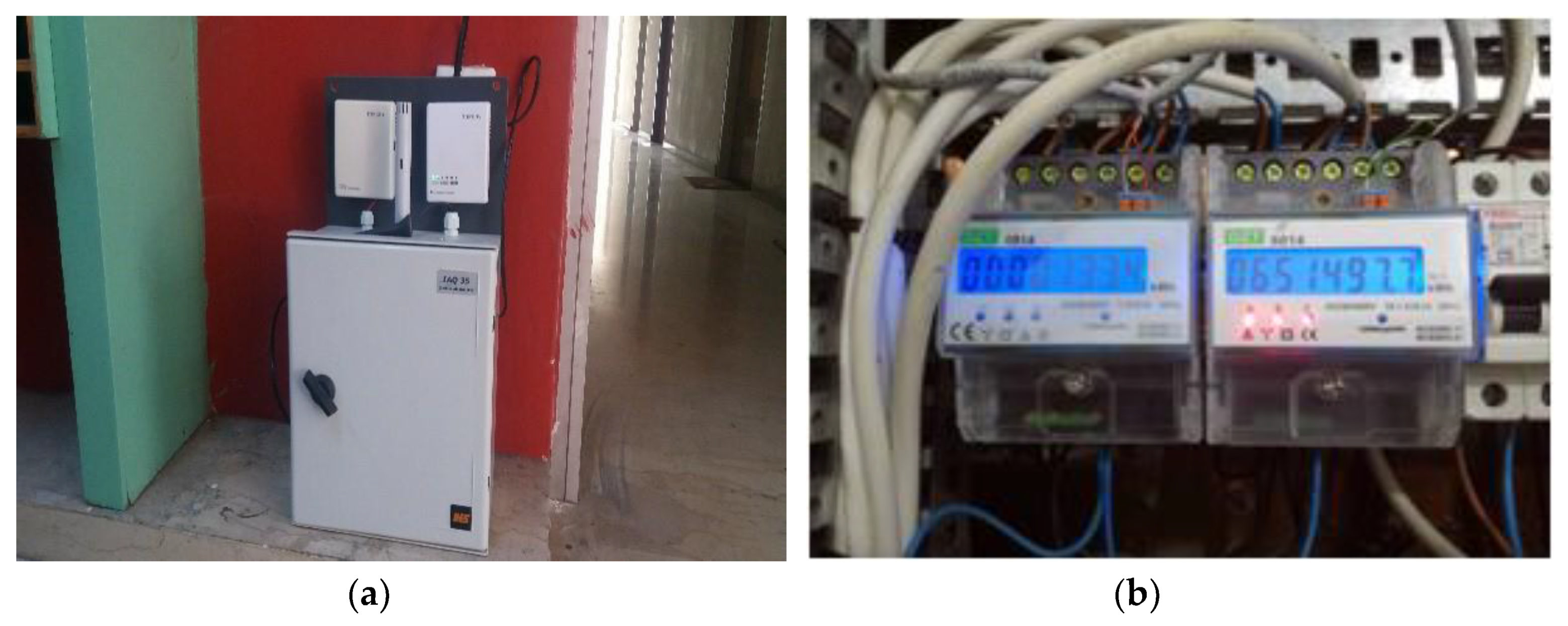
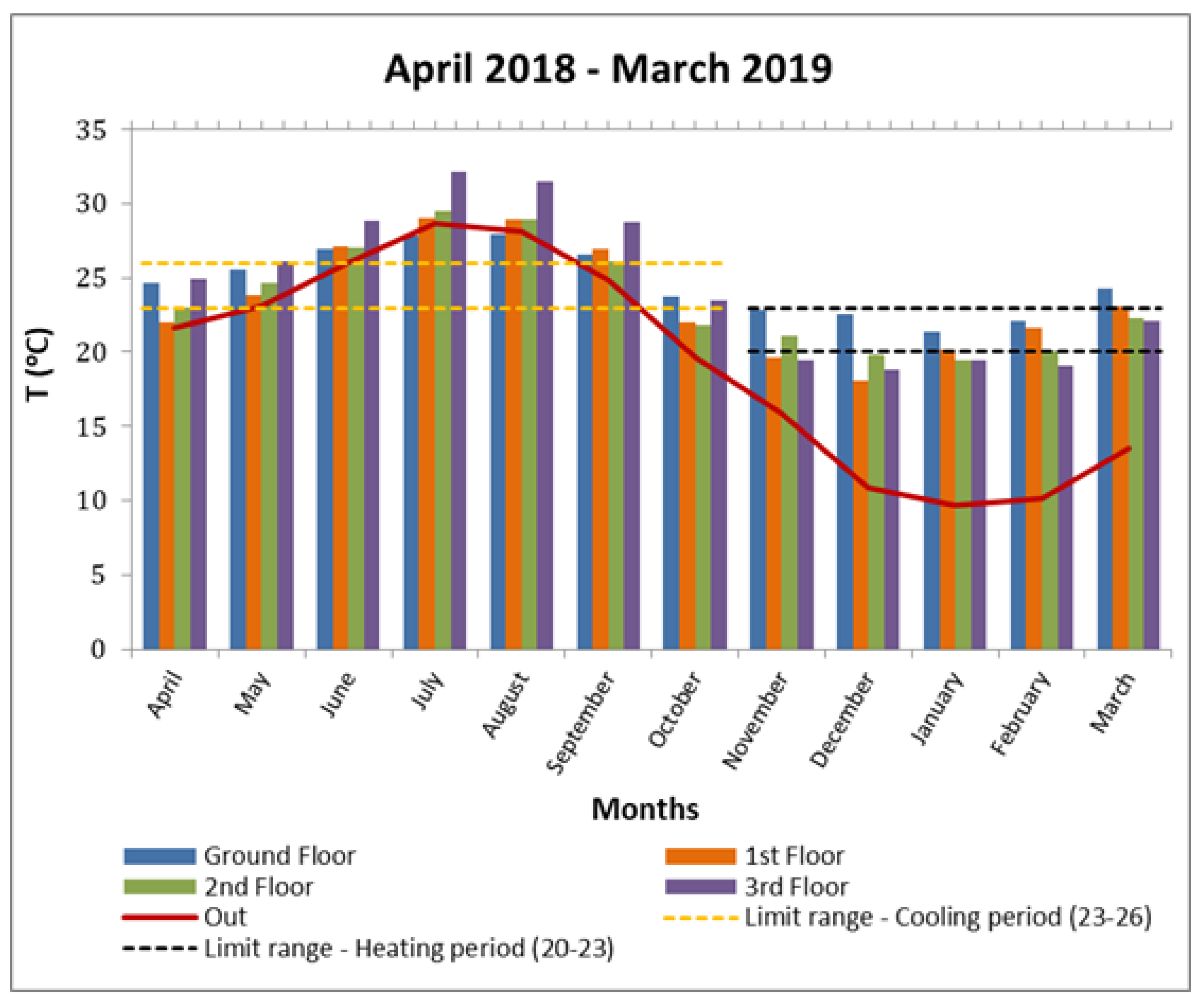
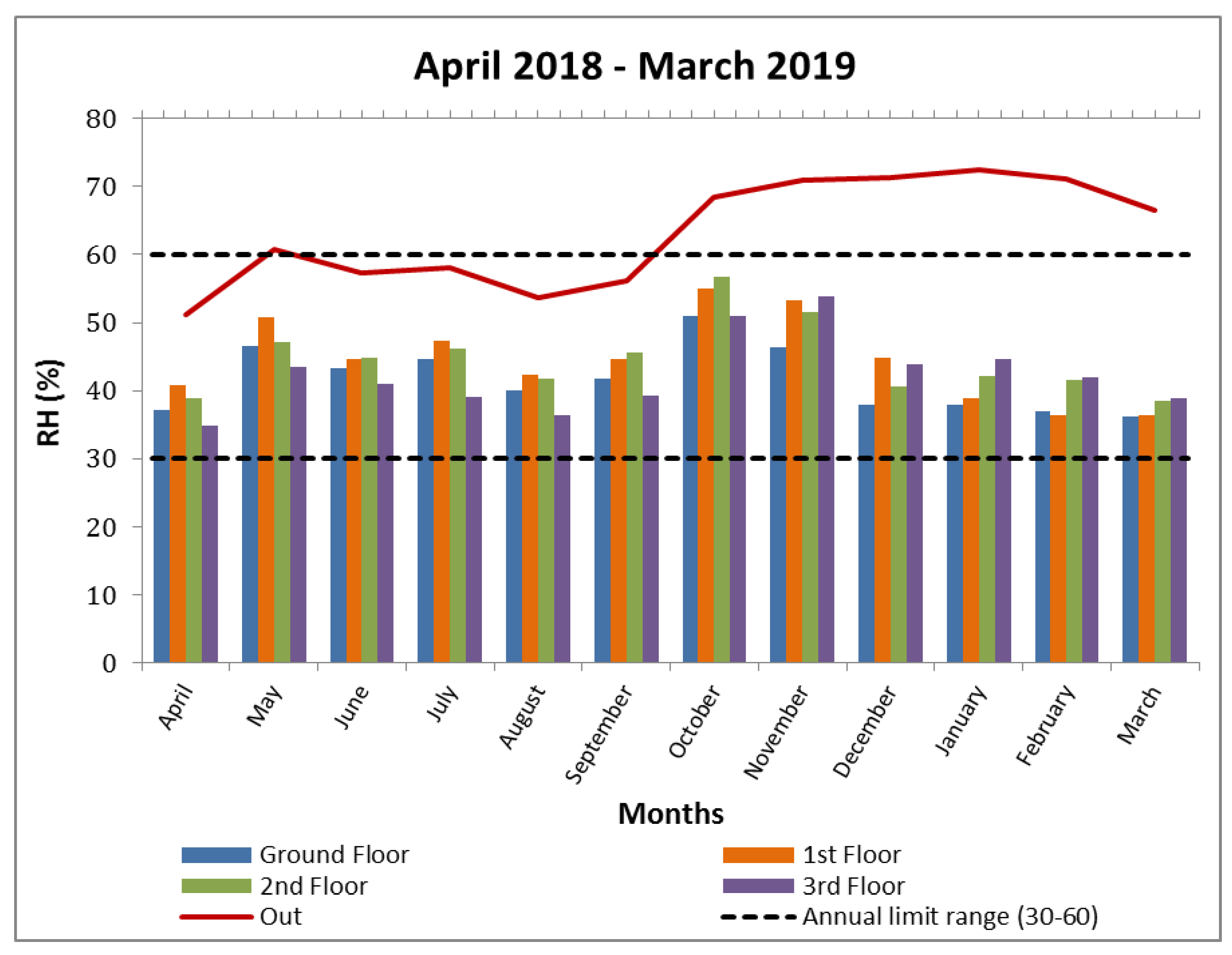
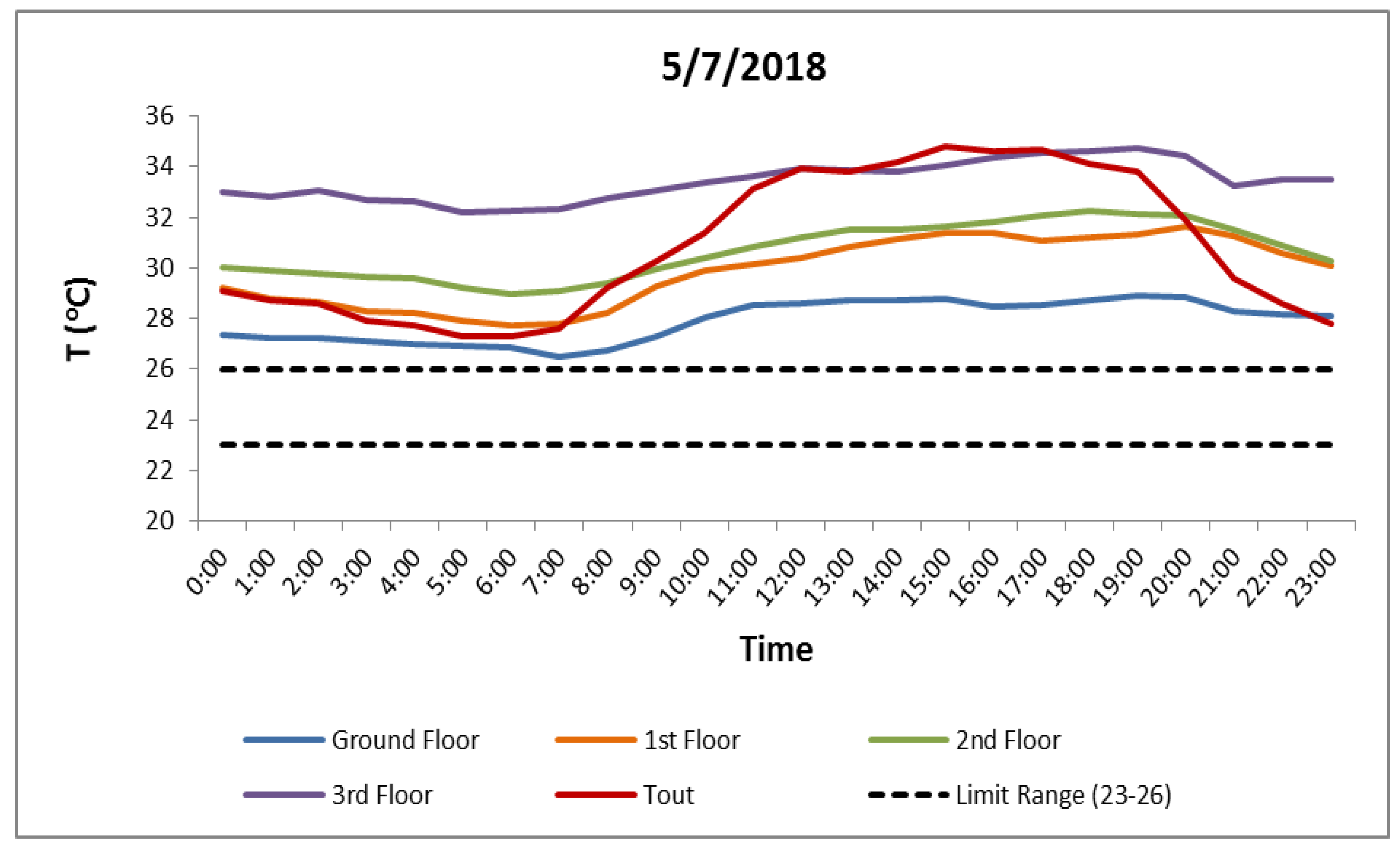
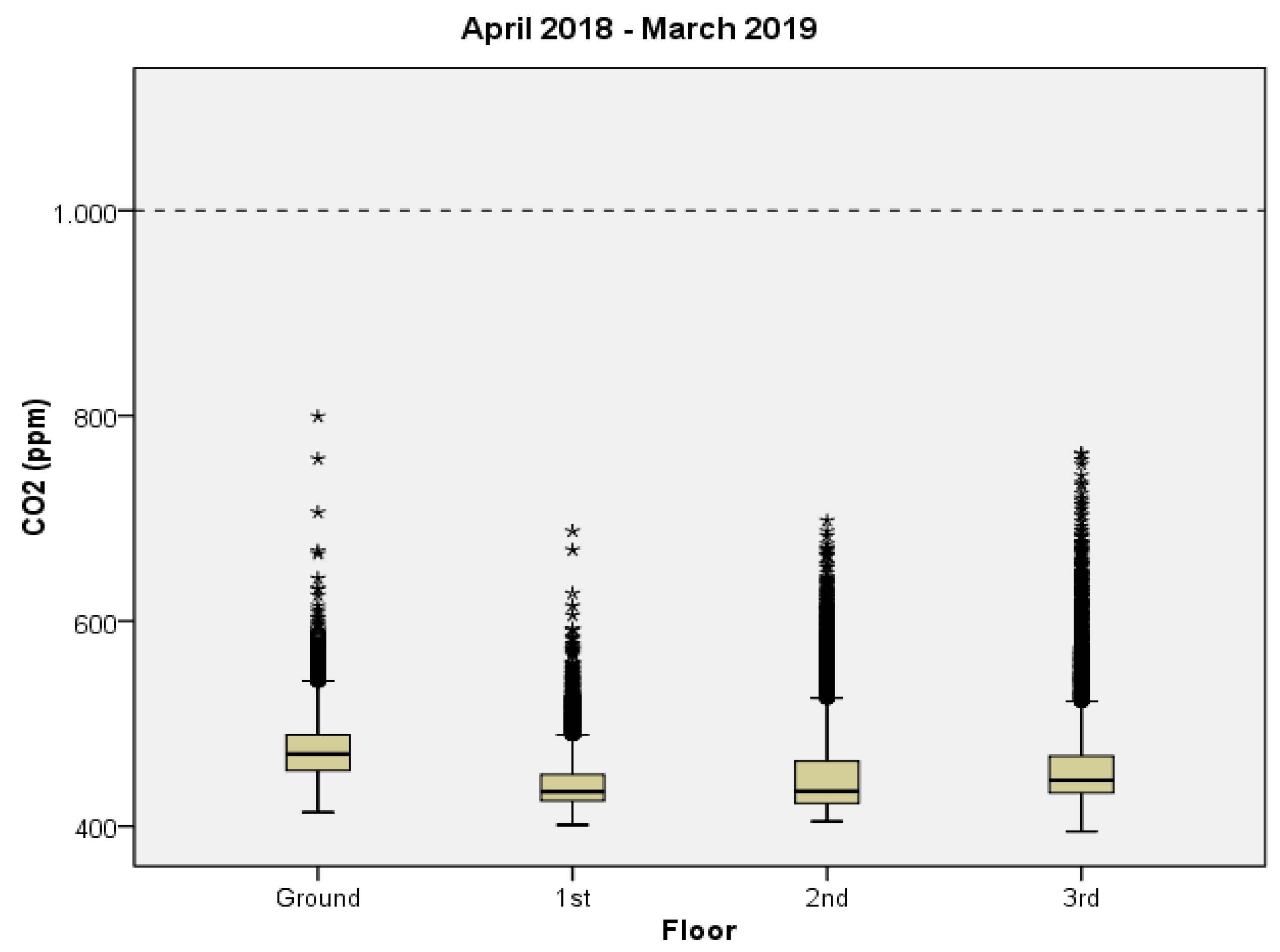
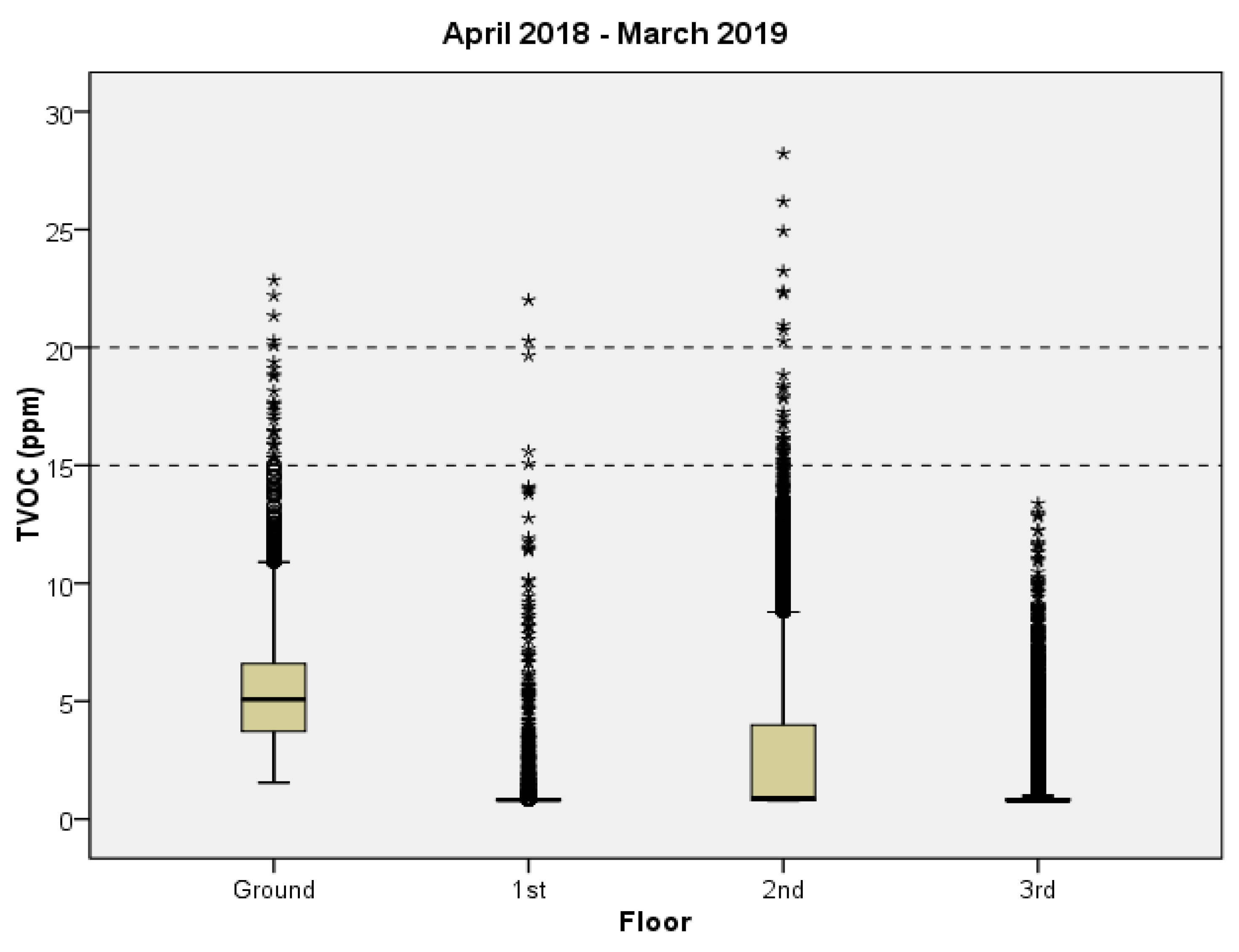
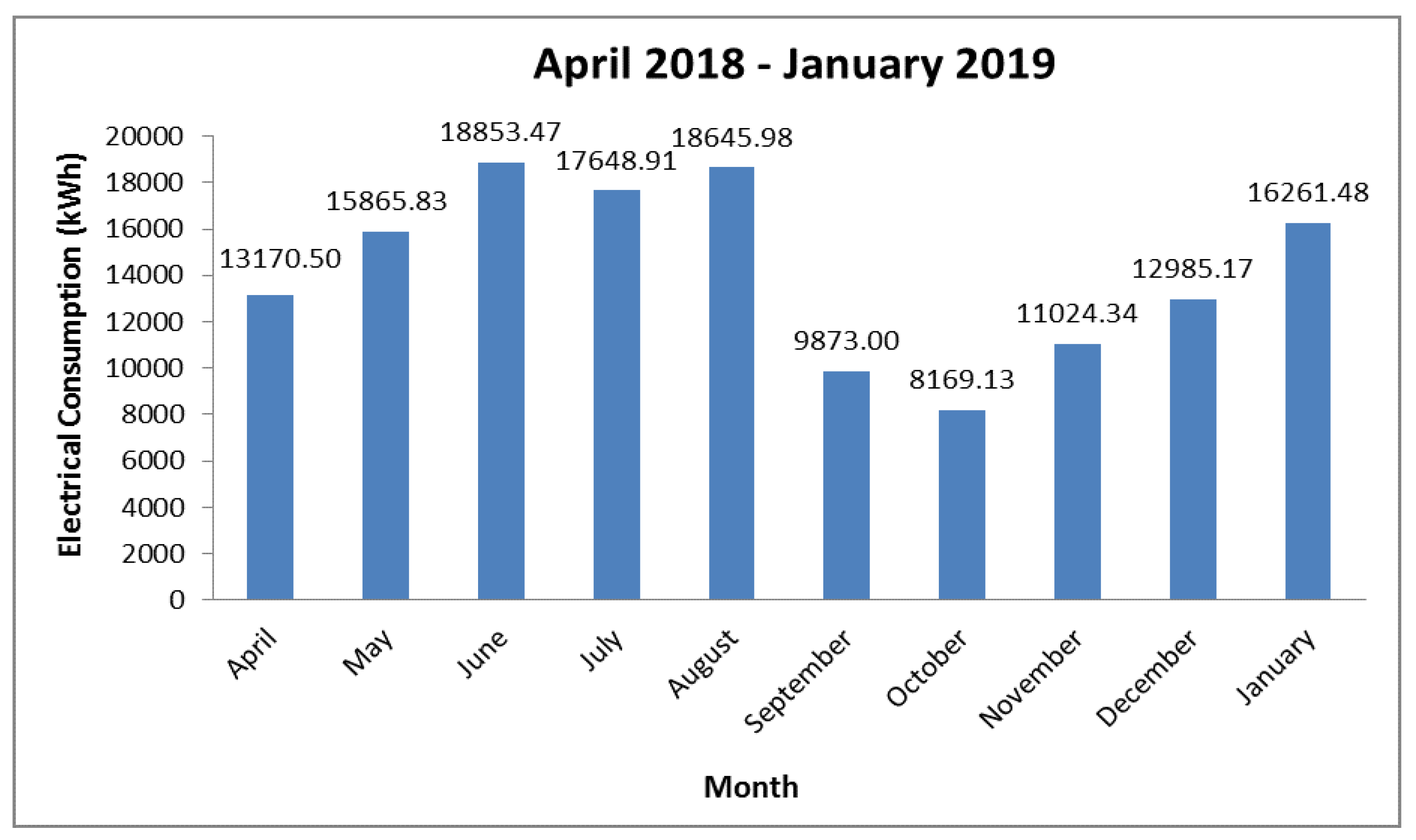
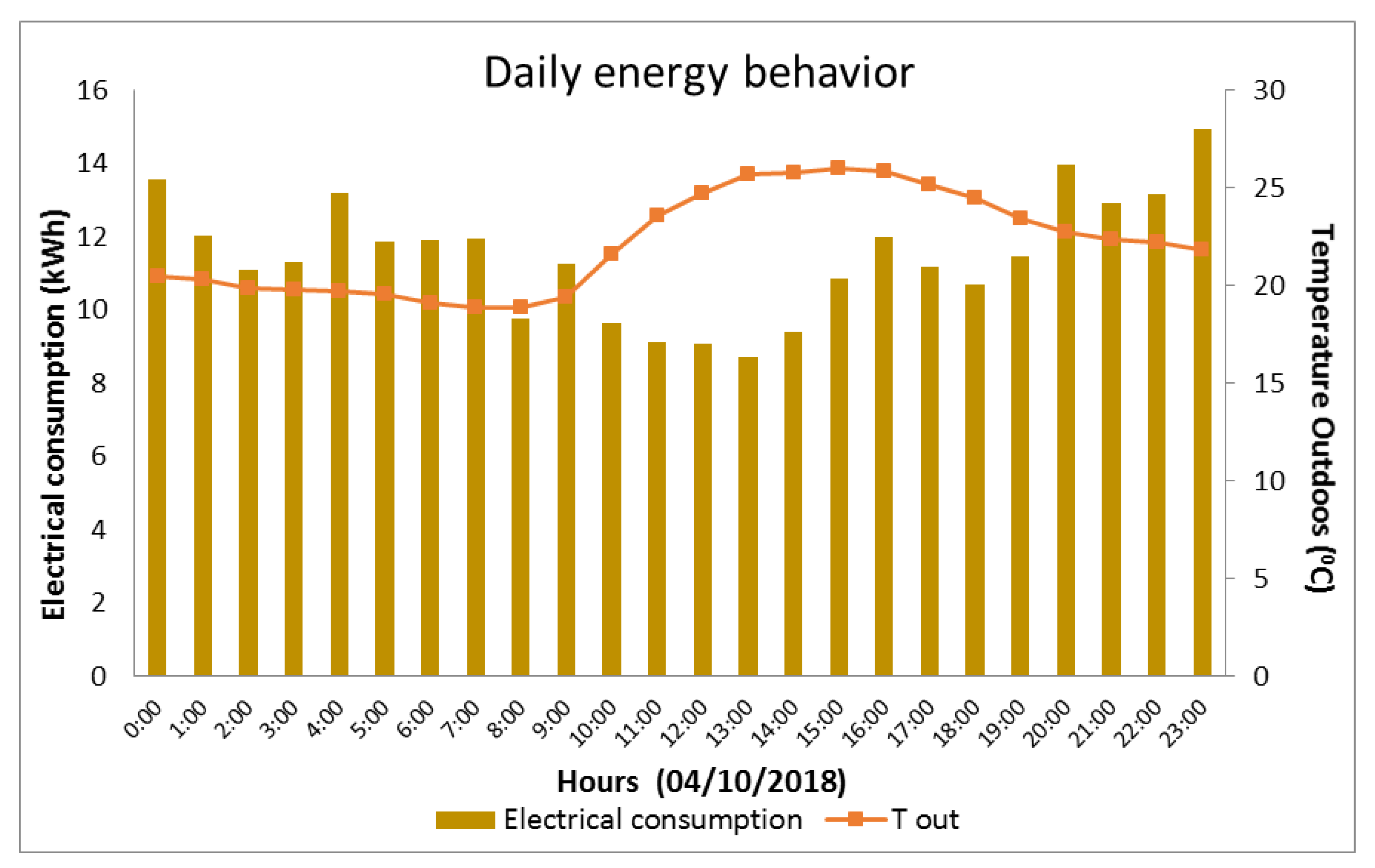
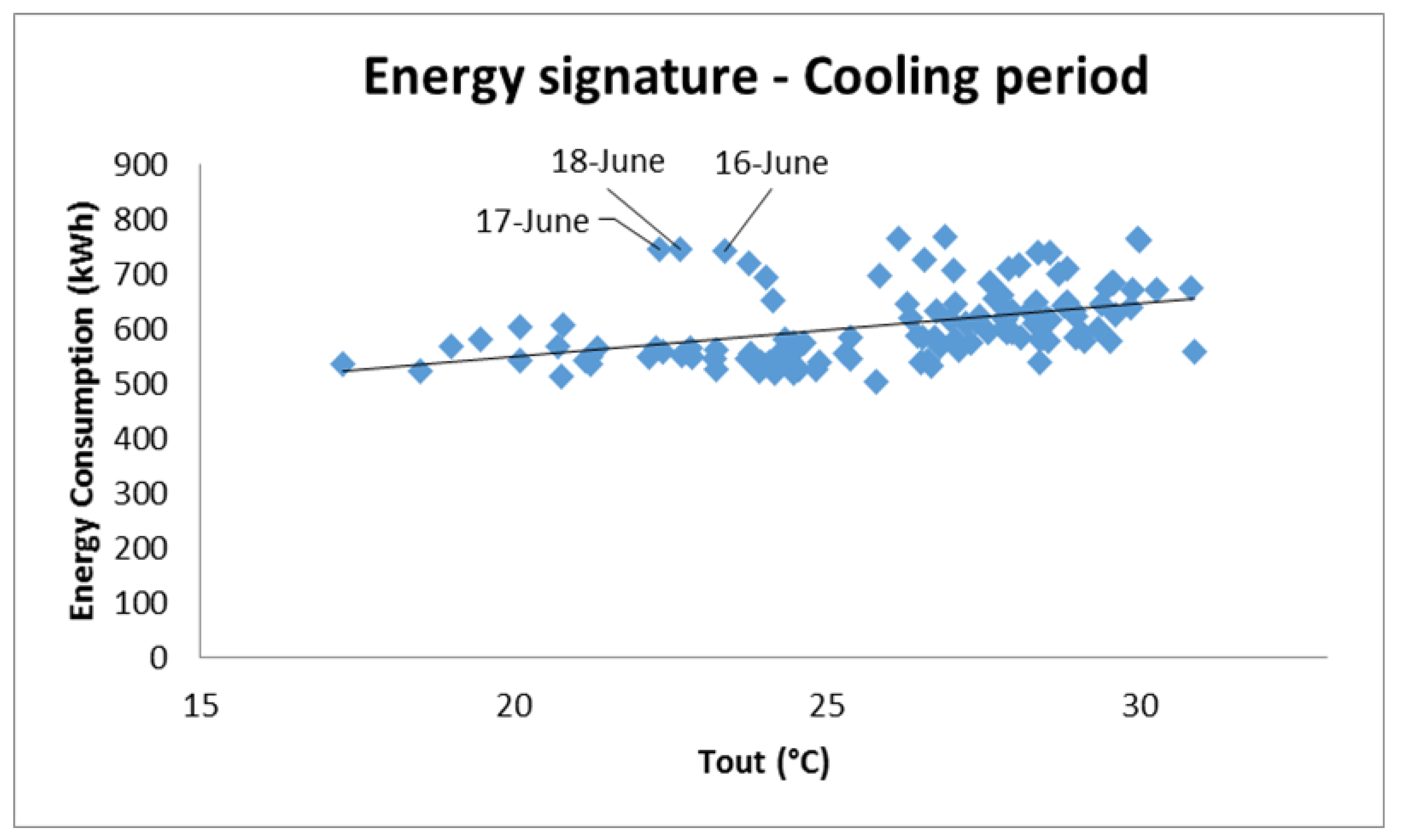
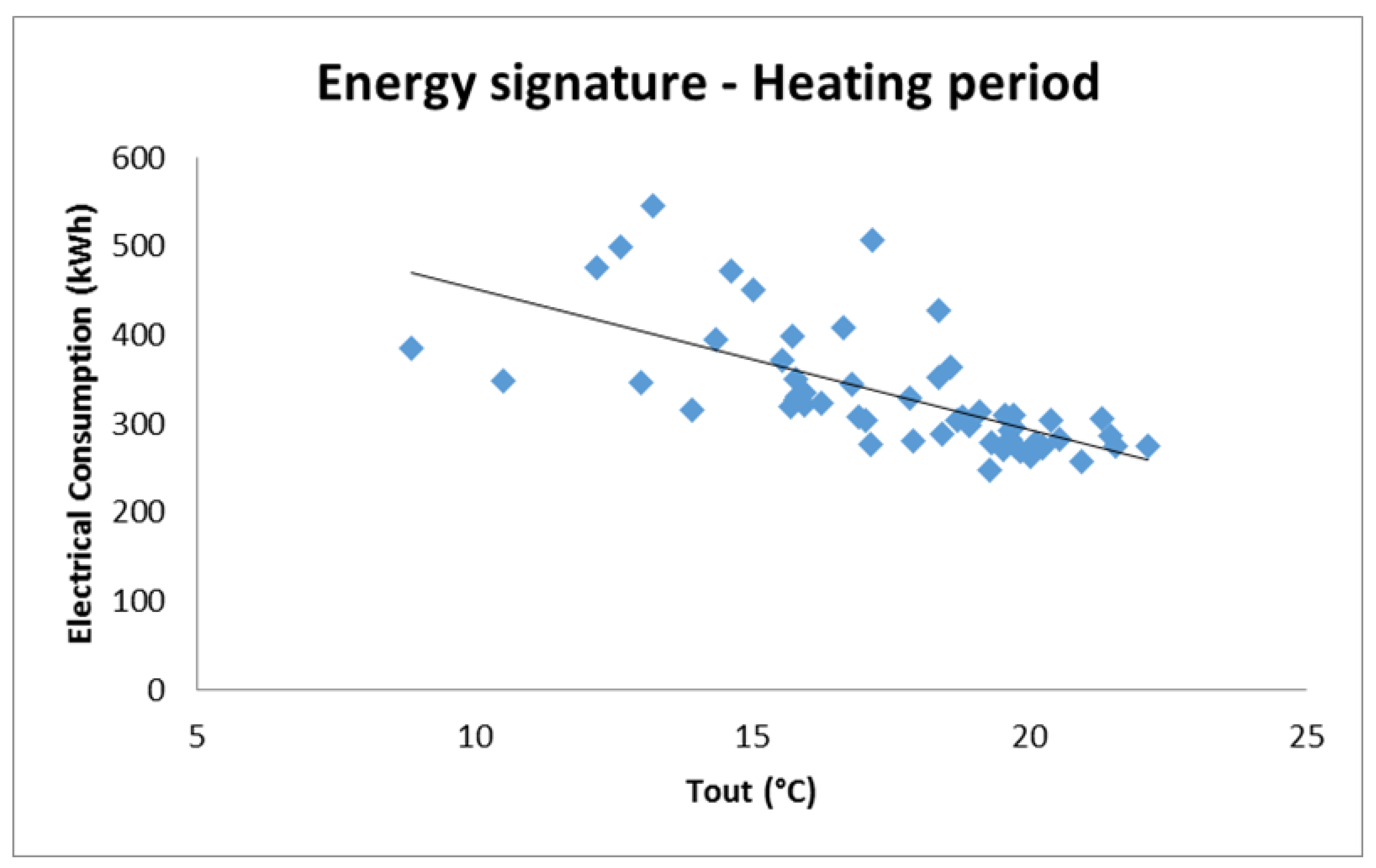
| Location | Area Elevation | Elevation | Number of Bedrooms | Planimetric Dimensions |
|---|---|---|---|---|
| Basement | 742 m2 | 2.60 m | 0 | 56.59 × 13.36 m2 |
| Ground-floor | 725 m2 | 2.40 m | 36 | 56.59 × 15.37 m2 |
| First floor | 725 m2 | 2.40 m | 36 | 56.59 × 15.37 m2 |
| Second floor | 725 m2 | 2.40 m | 36 | 56.59 × 15.37 m2 |
| Third floor | 725 m2 | 2.40 m | 36 | 56.59 × 15.37 m2 |
| Experimental Site | ||||||
|---|---|---|---|---|---|---|
| Month | Parameter | Ground Floor | 1st Floor | 2nd Floor | 3rd Floor | Outdoors |
| April | T (°C) | 24.69 ± 1.07 | 22.00 ± 1.99 | 23.01 ± 1.91 | 24.94 ± 2.09 | 21.68 |
| RH (%) | 37.12 ± 4.84 | 40.79 ± 6.34 | 38.86 ± 5.73 | 34.92 ± 4.58 | 51.22 | |
| May | T (°C) | 25.58 ± 1.38 | 23.85 ± 2.29 | 24.64 ± 1.39 | 26.12 ± 1.40 | 23.13 |
| RH (%) | 46.48 ± 7.25 | 50.74 ± 11.35 | 47.18 ± 7.84 | 43.54 ± 7.03 | 60.73 | |
| June | T (°C) | 26.97 ± 1.16 | 27.16 ± 1.76 | 27.05 ± 1.94 | 28.83 ± 1.57 | 25.99 |
| RH (%) | 43.30 ± 8.56 | 44.64 ± 9.91 | 44.91 ± 11.23 | 41.07 ± 8.87 | 57.25 | |
| July | T (°C) | 27.86 ± 0.82 | 29.03 ± 1.81 | 29.46 ± 1.58 | 32.11 ± 1.36 | 28.67 |
| RH (%) | 44.6 ± 5.57 | 47.42 ± 8.61 | 46.28 ± 8.09 | 39.07 ± 6.55 | 58.13 | |
| August | T (°C) | 27.93 ± 0.70 | 28.91 ± 1.35 | 28.93 ± 1.22 | 31.47 ± 0.92 | 28.14 |
| RH (%) | 40.02 ± 5.07 | 42.30 ± 7.55 | 41.73 ± 7.44 | 36.41 ± 6.32 | 53.59 | |
| September | T (°C) | 26.54 ± 1.35 | 26.94 ± 2.25 | 26.13 ± 2.62 | 28.72 ± 2.59 | 24.85 |
| RH (%) | 41.69 ± 6.76 | 44.56 ± 9.05 | 45.70 ± 9.62 | 39.39 ± 0.90 | 56.16 | |
| October | T (°C) | 23.7 ± 0.72 | 22.00 ± 1.46 | 21.79 ± 0.85 | 23.43 ± 0.89 | 19.60 |
| RH (%) | 50.96 ± 7.48 | 55.00 ± 9.10 | 56.82 ± 8.77 | 50.97 ± 8.44 | 68.37 | |
| November | T (°C) | 22.87 ± 1.60 | 19.66 ± 2.12 | 21.14 ± 1.53 | 19.49 ± 1.92 | 15.90 |
| RH (%) | 46.46 ± 6.36 | 53.31 ± 8.36 | 51.51 ± 6.95 | 53.79 ± 7.85 | 70.97 | |
| December | T (°C) | 22.57 ± 1.05 | 18.10 ± 3.46 | 19.79 ± 1.89 | 18.81 ± 1.86 | 10.89 |
| RH (%) | 37.86 ± 4.38 | 44.80 ± 8.23 | 40.68 ± 6.08 | 43.87 ± 3.32 | 71.39 | |
| January | T (°C) | 21.36 ± 1.90 | 20.22 ± 3.39 | 19.43 ± 2.24 | 19.49 ± 1.47 | 9.66 |
| RH (%) | 37.90 ± 5.42 | 38.85 ± 8.53 | 42.19 ± 6.91 | 44.58 ± 6.29 | 72.49 | |
| February | T (°C) | 22.11 ± 1.51 | 21.64 ± 2.19 | 20.07 ± 1.62 | 19.08 ± 2.04 | 10.12 |
| RH (%) | 37.04 ± 4.27 | 36.38 ± 5.00 | 41.67 ± 5.95 | 41.97 ± 3.74 | 71.03 | |
| March | T (°C) | 24.30 ± 1.25 | 23.13 ± 2.03 | 22.33 ± 1.83 | 22.14 ± 1.52 | 13.51 |
| RH (%) | 36.14 ± 3.13 | 36.51 ± 4.90 | 38.55 ± 4.87 | 38.94 ± 4.33 | 66.56 | |
| Month | B FEPA Building (%) | Ground Floor (%) | 1st Floor (%) | 2nd Floor (%) | 3rd Floor (%) |
|---|---|---|---|---|---|
| April | 53.57 | 87.15 | 33.15 | 45.78 | 48.19 |
| May | 53.68 | 53.18 | 47.53 | 70.22 | 43.79 |
| June | 18.63 | 17.78 | 24.03 | 28.75 | 3.97 |
| July | 2.19 | 0.69 | 5.77 | 2.28 | 0.00 |
| August | 1.08 | 0.54 | 2.02 | 1.75 | 0.00 |
| September | 24.76 | 35.69 | 25.81 | 25.86 | 11.68 |
| October | 47.42 | 84.62 | 29.65 | 3.60 | 71.83 |
| November | 44.56 | 55.62 | 40.69 | 49.22 | 32.69 |
| December | 35.64 | 56.45 | 27.38 | 49.09 | 9.64 |
| January | 39.51 | 49.06 | 37.37 | 38.1 | 33.53 |
| February | 51.11 | 62.65 | 60.42 | 52.38 | 29.00 |
| March | 43.32 | 15.71 | 34.29 | 60.00 | 63.3 |
| Total | 34.62 | 43.26 | 30.68 | 35.59 | 28.97 |
| Statistics | Ground Floor (ppm) | 1st Floor (ppm) | 2nd Floor (ppm) | 3rd Floor (ppm) | |
|---|---|---|---|---|---|
| Mean | 474 | 442 | 452 | 461 | |
| Standard Deviation | 28 | 26 | 46 | 48 | |
| Coefficient of Variation | 5.91% | 5.88% | 10.18% | 10.41% | |
| Minimum | 414 | 401 | 405 | 395 | |
| Maximum | 799 | 688 | 698 | 763 | |
| Percentiles | 25 | 454 | 425 | 422 | 433 |
| 50 (median) | 470 | 434 | 434 | 445 | |
| 75 | 489 | 450 | 463 | 468 | |
| Statistics | Ground Floor (ppm) | 1st Floor (ppm) | 2nd Floor (ppm) | 3rd Floor (ppm) | |
|---|---|---|---|---|---|
| Mean | 5.38 | <1 | 2.79 | 1.47 | |
| Standard Deviation | 2.31 | <1 | 3.17 | 1.66 | |
| Coefficient of Variation | 42.94% | 92.47% | 113.62% | 112.93% | |
| Minimum | 1.54 | <1 | <1 | <1 | |
| Maximum | 22.85 | 22.01 | 28.22 | 13.38 | |
| Percentiles | 25 | 3.72 | <1 | <1 | <1 |
| 50 (median) | 5.08 | <1 | <1 | <1 | |
| 75 | 6.59 | <1 | 3.99 | <1 | |
© 2019 by the authors. Licensee MDPI, Basel, Switzerland. This article is an open access article distributed under the terms and conditions of the Creative Commons Attribution (CC BY) license (http://creativecommons.org/licenses/by/4.0/).
Share and Cite
Barmparesos, N.; Papadaki, D.; Karalis, M.; Fameliari, K.; Assimakopoulos, M.N. In Situ Measurements of Energy Consumption and Indoor Environmental Quality of a Pre-Retrofitted Student Dormitory in Athens. Energies 2019, 12, 2210. https://doi.org/10.3390/en12112210
Barmparesos N, Papadaki D, Karalis M, Fameliari K, Assimakopoulos MN. In Situ Measurements of Energy Consumption and Indoor Environmental Quality of a Pre-Retrofitted Student Dormitory in Athens. Energies. 2019; 12(11):2210. https://doi.org/10.3390/en12112210
Chicago/Turabian StyleBarmparesos, Nikolaos, Dimitra Papadaki, Michalis Karalis, Kyriaki Fameliari, and Margarita Niki Assimakopoulos. 2019. "In Situ Measurements of Energy Consumption and Indoor Environmental Quality of a Pre-Retrofitted Student Dormitory in Athens" Energies 12, no. 11: 2210. https://doi.org/10.3390/en12112210
APA StyleBarmparesos, N., Papadaki, D., Karalis, M., Fameliari, K., & Assimakopoulos, M. N. (2019). In Situ Measurements of Energy Consumption and Indoor Environmental Quality of a Pre-Retrofitted Student Dormitory in Athens. Energies, 12(11), 2210. https://doi.org/10.3390/en12112210








